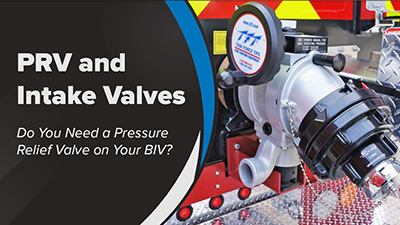Does Your Intake Valve Need a Pressure Relief Valve?
If you are evaluating intake valves, you may wonder if a pressure relief valve is needed. You may not be sure if your department really needs one or how to decide. There may be differing opinions within your department.
Overall, the decision to get a pressure relief valve or not depends a lot on department preference. We have a couple of scenarios where you could benefit from having it available, though.
In this article we are going to explore what a pressure relief valve is, when you might want one, and when you might not need to have one.
What is a Pressure Relief Valve?
A pressure relief valve does exactly what it says. If the incoming pressure to your intake valve rises too high, the valve relieves that extra pressure. Most pressure relief valves can be set to your desired pressure, ours range from 90 – 300 PSI, meaning you aren’t stuck with a factory setting or range that isn’t suitable for your needs.
With our intake valves, the pressure relief valve can be set to your desired pressure in the field with a common socket wrench or Allen wrench. If there is excess pressure, the pressure relief valve will open. This process does expel water from the valve, meaning you might end up in the splash zone! Some departments mitigate this issue by using a basic radiator hose and hose clamp to redirect that water.
Why Would You Want a Pressure Relief Valve?
Many departments choose to use a pressure relief valve to protect their pumps and internal plumbing or to be prepared when dealing with hot hydrants.
Protecting Your Pump
A pressure relief valve can protect your pump and internal plumbing from extreme water hammer. If there is a sudden surge of pressure, your relief valve will do its job and keep that excess pressure from moving to your truck’s internal plumbing.
Keep in mind, too much pressure may damage your pump or internal plumbing, abruptly stopping your ability to move water to the fire. Protecting your pump is an important part of safe fire ground operations.
Dealing with Hot Hydrants
In some areas the fire hydrants have a very large water main or elevation gain because of the terrain. These hydrants are well fed and have a high hydrant pressure. This is great in terms of moving a lot of water but can spell disaster if there is a sudden surge of pressure. A hot hydrant can easily do damage to your pump and internal plumbing if you are not careful. For this reason, some departments choose to use an intake valve with a pressure relief valve.
When Might You Not Need a Pressure Relief Valve?
To be clear, we recommend having one for the sake of protecting your equipment. There are some departments that may never use a pressure relief valve, though.
Low-Pressure Hydrants
If you run in an area that typically has lower pressure hydrants, like the Midwest region of the United States, you may not need a pressure relief valve. These hydrants are extremely unlikely to send a pressure surge large enough to damage your pump. In fact, you might be looking for ways to boost your pressure and flow to adequately attack a fire.
Explore the Oasis Hydrant Assist Valve here!
The Bottom Line
Many departments rely on personal preference when it comes to a pressure relief valve on their intake valves. Your department may or may not decide to use one. We recommend considering the information above before making a final decision.
